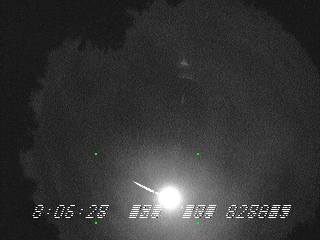Earth Sweeps Up Another Near Earth Object December 9, 2008
Posted by skywalking1 in Space.trackback
We have been fortunate this fall to witness the impact of at least three small Near Earth Objects, that of 2008 TC3 in October (burned up over Sudan on October 7), the Canadian fireball of November 20, and this Colorado fireball, which struck on December 6 and burned up high in the atmosphere with a brightness equivalent to 100 full moons:

All-sky camera view of Colorado fireball -- December 6, 2008
(image — Chris Peterson, Cloudbait Observatory, CO)
The Buzzard Coulee Sasketchewan fireball produced a plentiful meteorite fall, and observers of this Colorado event are searching for fragments from this latest asteroid impact.
News reports commented on how both the Sasketchewan and Colorado fireballs (and meteorite falls) went unpredicted by “NASA”, as if the space agency were on the lookout. Although NASA is completing its search for NEOs larger than 1 km in diameter, detection of objects this small (roughly a meter or two in diameter) is completely a matter of luck. 2008 TC3 was picked up just a day from impact, because it happened to be in the field of view of one of the NASA-funded NEO search telescopes. But there is no systematic search for asteroid fragments this small (which detonate with the energy of several hundred tons of TNT).
The National Research Council is commencing this month a study of how NASA might extend the search for NEOs to smaller diameters (about 140 meters across, in the latest Congressional direction) and analyze options for deflecting such hazardous bodies. Rusty Schweickart, my colleague at the Association of Space Explorers NEO Committee, has just completed briefing UN ambassadors in Vienna, and will testify before the NRC study team later this week. Our ASE effort is aimed at the international adoption of a decision-making program to deal with future, and potentially destructive, asteroid threats.
Read more about the NEO hazard at my website, under “Planetary Science.”
Comments»
No comments yet — be the first.